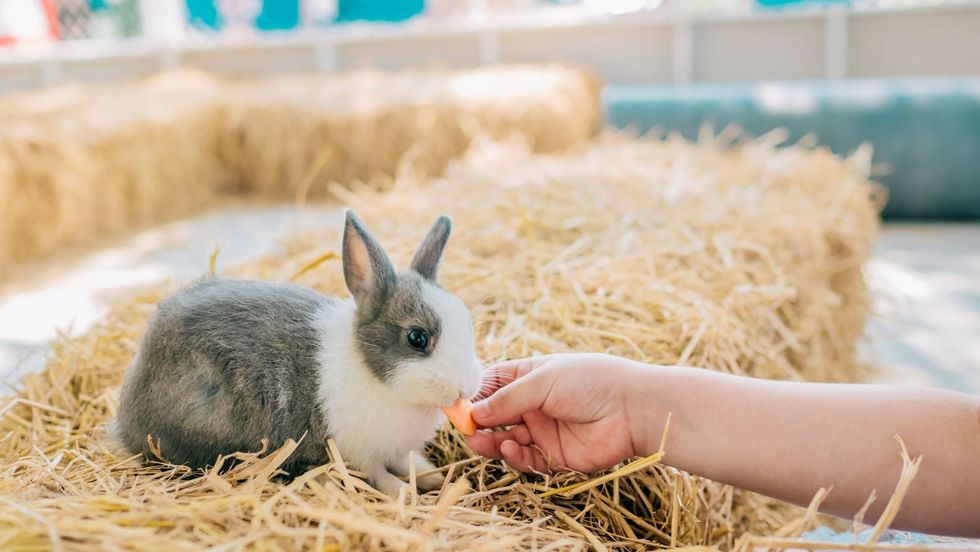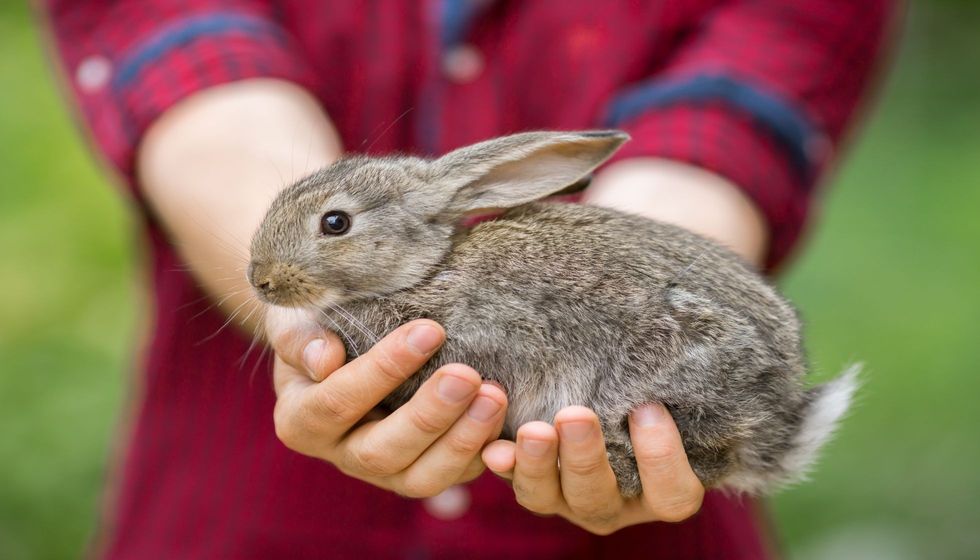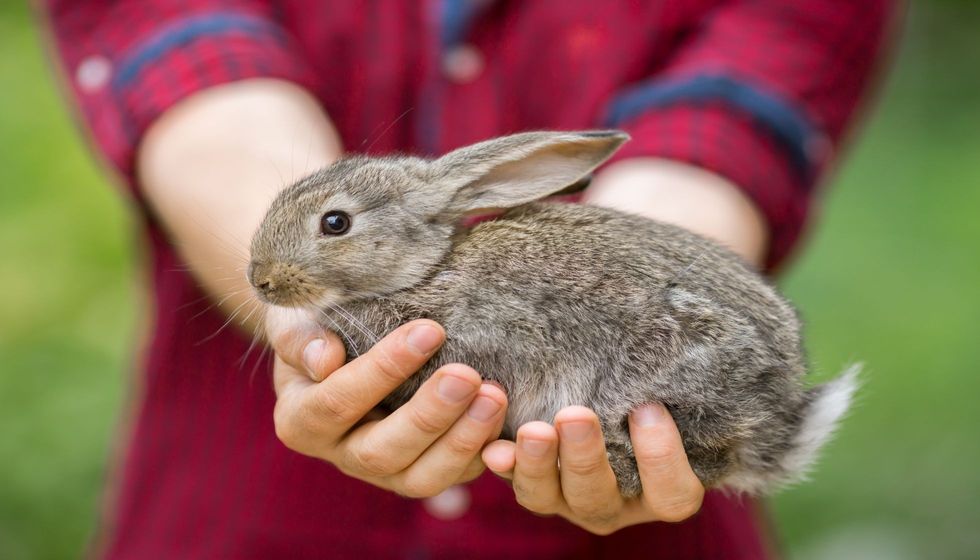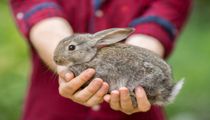Rabbit Care: How To Take Care Of A Baby Bunny?
Bunnies might perhaps be the cutest animals you could pet and play with.
Usually there is a mother rabbit to feed babies twice a day and nurse them, but if that isn't the case, there are a number of things you need to keep in mind.
Baby rabbits, known as kit or kittens, are very fragile when they are born; the first thing you should take care of is the surroundings they live in.
For starters, you need to replicate the function of a nest which rabbits make in the wild when a young one is born.
A makeshift cardboard box would do. As a baby bunny is born without fur, it needs to be kept warm.
This nest should comfortably accommodate the mother rabbit and the baby bunny along with a sanitized towel and some clean, pesticide free grass.
Towels provide cleanliness as a baby rabbit is vulnerable to various elements after birth. To maintain hygiene you can also use a cotton ball to gently stroke the anal area of your rabbit and clean it when it is one to two weeks old.
The grass and hay provide some warmth as well as simulate the surroundings of a wild rabbit.
While making the carboard nest you must keep in mind that it should be of adequate size so that the mother rabbit can hop in and out.
You can possibly make one of the walls shorter than other ones so that the mother rabbit can enter and exit easily but baby bunnies cannot jump out. While taking care of your baby rabbit, another important thing you should keep in mind is to place the box in dark until the baby rabbit opens its eyes.
You also need to be aware of the temperature of the room your rabbit is in.
Optimally, the room temperature in which your baby rabbit is kept should be 65-70 F (18-21 C). However, if you are staying in a cold place or have decided to buy a baby rabbit in a colder month, you need to take some additional care.
The best possible way to handle this is to place an electric heating pad under the cardboard nest or any other bedding your rabbit is kept in.
Keep the heating pad at a low setting so that the surface is not too warm. If you don't have a heating pad, you can use a warm water bottle as a makeshift one.
Ensure that there is an area in the box which is not as warm as the other part, so that your rabbits can move to the colder section as and when it needs to.
If you enjoy this article, why not also read about how to take care of a box turtle and how to take care of a hedgehog here on Kidadl?
What do newborn baby bunnies eat?
It doesn't have to be difficult to take care of your baby rabbit. Some important points you need to keep in mind include the surroundings or the habitat of your rabbit.
Always keep the room dark until your baby rabbit's eyes open. Regulate the temperature of the room.
Other than these basic necessities, you need to bunny proof your house as rabbits need to roam around; take care of any sort of wires, sharp edges, broken pipes or any other hazardous materials.
As rabbits tend to hop around the house and enjoy freedom and exercise, it is your responsibility to make sure that their living area is safe. Be careful about the food you provide them and take your wild rabbit to the veterinarian as per schedule.
There are specific foods you can feed a baby rabbit. Do not feed the food you provide to an older rabbit to a your newborn pet rabbit.
The best food to give to your baby rabbit is KMR kitten powder formula. Turn this powder into a solution and feed it to your pet rabbit using a small syringe or an eyedropper.
Proportions to create this formula made from kitten milk replacer should be three parts solid to four parts of distilled water. This formula should be made in warm water.
The formula need not be very hot, and feed it to your pet rabbit only when you can comfortably touch the formula without it feeling uncomfortably hot.
The solution will then be perfect for your rabbit. Do not forget to keep a tissue nearby to prevent any formula from entering your rabbit's nose, otherwise it could possibly lead to choking.
The best time to feed pet rabbits is twice per day during dawn and dusk as it has been scientifically tested that following this pattern would be best for digestion of your rabbit. While feeding your rabbit, take care of the quantity of food you give to it.
Give up to 0.08 fl oz (2.5 ml) to baby rabbits that are newborn.
Give up to 0.16-0.23 fl oz (5-7 ml) to your rabbit when it is around one to two weeks old.
When the rabbit is between two to three weeks old, feed it up to 0.23-0.43 fl oz (7-13 ml).
When your pet rabbit is between three to six weeks old, feed it a maximum of 0.5 fl oz (15 ml).
Can you touch baby bunnies?
In an ideal setting, you can softly touch a newborn rabbit if it’s a pet rabbit and only if the mother is serene with your presence around its young one.
On the other hand, it is advisable not touch a newborn wild rabbit unless it is abandoned and needs your care. It is a prevalent notion that if a mother rabbit gets your scent on her young one, she won't feed it.
This is a myth when it comes to domestic rabbits as the mother rabbit is accustomed to human touch but this might not be the case for wild rabbits.
Even though you can touch and handle domesticated newborn baby rabbits, it is recommended not to. A newborn rabbit is very fragile and prone to diseases.
Additionally, rabbits, being a prey species, often get stressed when in human contact for a very long duration.
However, at times, you may need to touch a newborn baby rabbit.
For example, if a newborn falls out of its cardboard nest, it needs to be put back in it immediately. Staying away from the litter at such a young age might quite possibly lead to its death due to diseases and cold temperature.
Touch and handle baby rabbits only when necessary and for short durations. A very important factor here is the hygiene standard you need to maintain while handling baby rabbits, especially wild rabbits, as they are still considered wild animals.
You must always wear gloves while touching baby rabbits, especially when they are young and you must be very gentle when you do so.
Apart from wearing gloves, always wash your hands with soap and water before and after touching rabbits in order to avoid the spread of any disease.
E. coli is one such disease which is very common among rabbits and can kill them even before you realize something is wrong. During the first two months, while rabbits are being nursed and weaned either by their mother rabbits or solely by you, it is a good idea to keep touching to a minimum.
However, after the first two months when the babies have grown, it is a good idea to handle them regularly to get them accustomed to human touch and scent. The reason behind getting them habitual with human touch is to get them comfortable with the same and to not be hostile to human touch.
Moreover, you should not touch baby rabbits during the first seven days after they are born as bunnies tend to get their fur after seven days after being born.
This reduces the chances of getting cold as well as other diseases.
In the next five to seven days, rabbits are known to develop a thicker, more protective layer of fur around their body. However, these rabbits get their adult fur coat only once they are 3-12 months of age when they shed their softer fur.

How do you take care of baby bunnies?
The fact that bunnies tend to eat, sleep and litter all in the same place speaks leaps and bounds about how much you need to take care of your pet even if it has a mother rabbit.
For wild rabbits, you need to follow all the basic hygiene standards and some additional ones too as wild rabbits might carry certain diseases owing to their wild habitat.
People often think it is difficult to keep a baby bunny alive after its mother has passed away or abandoned it. In reality, it isn't that difficult as all you need to do is stick to basics.
Provide a safe and warm shelter and feed it KMR kitten formula.
If provided with proper food and warmth, the bunny is sure to survive. Make sure that it is staying in a clean and dark environment until its eyes open.
In rare cases, if you find a nest with an injured wild baby bunny near it, take it to a wildlife rehabilitator as soon as possible. If you find wild bunnies abandoned, begin to take care of them only if you have confirmation that they have been orphaned.
On observing the situation, you can figure out if the wild rabbit is hungry or stressed.
If it is sleeping all day, it means that the rabbit is well fed.
On the other hand, if the rabbit is crying, it shows that it is either stressed or has been abandoned. If you notice a tinge of blue skin on the bunny, it reflects that it is hungry.
Once you have brought the bunny home, the first and foremost priority is to set up a warm and comfortable bed for the bunny. As mentioned earlier, you can use a cardboard box for the same and lay clean, soft, cotton towels at the bottom of it.
Temperature regulation is another important factor to keep in mind.
Once the cardboard box is ready and the wild bunny is placed in the box, cover the top with a clean towel to keep the box dark and to ensure air circulation.
Resembling a habitat similar to the wild habitat will help the baby rabbit to grow without any stress. Also, you can add some timothy hay or oat hay to the cardboard box as a supplement, and once you notice it eating hay, the wild baby is now ready to rejoin local wildlife.
To ensure a healthy growth of your bunny, you need to change your rabbit's bedding and towel daily. You need to do this until your bunny is strong enough to move out the box on its own.
You can also introduce your pet to hay pellets when it is around two weeks old, and it will nibble at these pellets.
It will require nursing until it is eight weeks old.
Nursing is required as the mother passes on antibodies which are important in developing a healthy immune system in the rabbit's body. The change from mother's milk to pellets will be slow and gradual; all you need to do is provide fresh pellets everyday and remove old ones to avoid any sort of bacterial growth.
Steps To Take Care Of A Baby Bunny
To take care of a pet as fragile and as sophisticated as a bunny, you need to be extra careful at every step. From bunny proofing your house to providing a fine bed to maintaining hygiene protocols, the procedure of taking care of a baby rabbit is elaborate but fun and doable.
Below are steps you need to follow in order to be capable of taking care of your bunny.
Step one: Have a safe indoor housing facility. There are a number of ways you can keep your bunny inside your home.
Your rabbit can live in a bunny proofed room or within a puppy pen, bunny condo, or even a large rabbit cage.
These living spaces will provide utmost safety to your bunny as it won't be vulnerable to dangerous items around your house.
You should keep in mind that if your bunny lives in the above mentioned conditions, its space should always be large enough to ensure that it can hop around and roam around a bit inside the cage.
It is also important that you let the rabbit come out of its cage in a safe area daily for a few hours so that it can exercise, as this is important for its growth.
Step two: Make time to bunny proof your house. Even if you keep your rabbits in a cage, they need to be let out once in a while as they need space to run around and explore.
To ensure a safe and sound environment for your bunny babies to roam around in, you have to bunny proof your house. Isn't it like having a child, anyway?
The process of bunny proofing your entire house involves covering all wires with plastic sleeves or you can lift them 3-4 ft (0.9-1.2 m) out of reach of your rabbit if possible.
The latter is much more safe as it eliminates any chance of your bunny reaching wires. You also need to take care of certain other items if you don't want them chewed, such as undersides of beds, items in your bookshelf or even house plants.
Rabbits like to chew on anything and everything. It's a good idea to provide them with a harmless chewing toy.
Step three: Providing fresh pellets or hay is necessary. Wild baby rabbits or even domesticated ones usually rely on mother rabbits for food.
However, if pet rabbits do not have the support of mother rabbits, you can feed your pet rabbits kitten milk twice a day, and after several days, provide hay pellets, too. Baby bunnies can also be provided with alfalfa in their diet.
Once your rabbits have grown up a bit, you need to feed them fresh hay.
It is wise to use a large feeder for hay as it stores a considerable amount of hay and keeps it dry and fresh, too. Rabbits need fresh water, and the best way to provide it is in a water dish beside their cardboard nest.
Step four: Setting up a litter box is essential. Interestingly, rabbits tend to eat and poop at usually the same time; you can smartly take advantage of this and encourage good litter box habits in your pet rabbit.
It is best to put a thin layer of rabbit-safe, recycled newspaper pellet litter at the bottom of the litter box to maintain hygiene and ensure that your baby rabbit does not get dirty every time.
Step five: Visit the vet at regular intervals in order to keep your rabbit's health in check. Rabbits are shy animals and it is their natural instinct to hide any sort of illness.
It is best to visit a vet at regular intervals to ensure the good health of your baby rabbit. Do keep an eye on the diet and litter cycle. Additionally, a visit to the vet will also provide assurance that your baby rabbit is developing in a healthy state.
Here at Kidadl, we have carefully created lots of interesting family-friendly facts for everyone to enjoy! If you liked our suggestions for how to take care of a baby bunny, then take a look at how to take care of baby ducks or rabbit facts.
We Want Your Photos!
More for You
Bachelor of Business Administration specializing in Marketing

Aryan KhannaBachelor of Business Administration specializing in Marketing
A dedicated and hardworking content writer currently pursuing his Bachelor's in Management Studies from St. Xavier's University, Kolkata. Aryan aims to gain corporate exposure and enhance his skills while creating well-researched and engaging content that is SEO-friendly. Aryan is a talented individual who puts in the effort to overcome any obstacle in his way.
Bachelor of Commerce specializing in Marketing and HR

Pradhanya RaoBachelor of Commerce specializing in Marketing and HR
With a Bachelor’s degree in Commerce from Christ University, Bangalore, Pradhanya's passion for the English language and literature led her to explore the field of content writing, where she has gained extensive experience in writing, reviewing, editing, and fact-checking. She has also earned certifications in Google Ads Search, Google Ads Display, and Social Media Marketing, showcasing her proficiency in digital marketing.
Disclaimer
1) Kidadl is independent and to make our service free to you the reader we are supported by advertising. We hope you love our recommendations for products and services! What we suggest is selected independently by the Kidadl team. If you purchase using the Buy Now button we may earn a small commission. This does not influence our choices. Prices are correct and items are available at the time the article was published but we cannot guarantee that on the time of reading. Please note that Kidadl is a participant in the Amazon Services LLC Associates Program, an affiliate advertising program designed to provide a means for sites to earn advertising fees by advertising and linking to Amazon. We also link to other websites, but are not responsible for their content.
2) At Kidadl, we strive to recommend the very best activities and events. We will always aim to give you accurate information at the date of publication - however, information does change, so it’s important you do your own research, double-check and make the decision that is right for your family. We recognise that not all activities and ideas are appropriate for all children and families or in all circumstances. Our recommended activities are based on age but these are a guide. We recommend that these ideas are used as inspiration, that ideas are undertaken with appropriate adult supervision, and that each adult uses their own discretion and knowledge of their children to consider the safety and suitability. Kidadl cannot accept liability for the execution of these ideas, and parental supervision is advised at all times, as safety is paramount. Anyone using the information provided by Kidadl does so at their own risk and we can not accept liability if things go wrong.
3) Because we are an educational resource, we have quotes and facts about a range of historical and modern figures. We do not endorse the actions of or rhetoric of all the people included in these collections, but we think they are important for growing minds to learn about under the guidance of parents or guardians.







